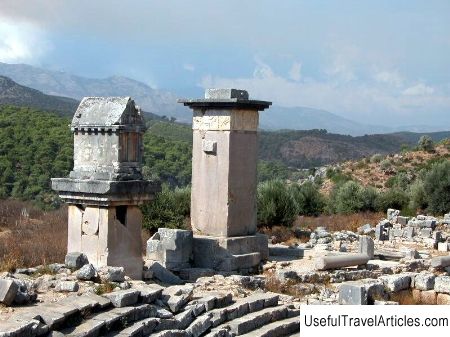Xanthos description and photo - Turkey
Rating: 8,0/10 (411 votes) 
Xanthos description and photo - Turkey. Detailed information about the attraction. Description, photographs and a map showing the nearest significant objects. The name in English is Xanthos. Photo and descriptionTo the southeast of Fethiye (at a distance of 65 km) on top of a hill are the ruins of Xanphos, an ancient city. From the top of the hill, on which the ruins are located, an unusually beautiful view of the Yeshen River valley opens. The city of Xanphos is described in the ancient Greek myth, which tells about Bellerophon and the flying horse Pegasus. King Iobatus lived in Xanphos, as well as Glaucus, the grandson of Bellerophon. In Homer's Iliad, Glaucus plays the role of a Lycian who fought for the Trojans. After archaeological excavations in the city, finds were discovered dating back to the 8th century BC. However, Xanphos was first mentioned in the chronicles of the conquest of Lycia, when a Persian general attacked Harpagus (540 BC). After the army of Harpagus surrounded the city, the defenders of the city realized that they were in a hopeless position. They decided to set fire to the city along with their houses, property, wives, children and slaves, while they continued to fight. Only 8 families managed to survive, since they were outside the city at that time. These families returned to rebuild the burnt city. In 333 BC. the city was taken over by Alexander the Great. After Alexander's death, Antigonos ruled the city, and after him Antiochus III. Under Antiochus III, Xanphos was the capital of the Lycian Union. A little later, Xanphos, like all of Lycia, controlled Rhodes. In 42 BC. in Rome, civil war was raging, and the city was under siege. It was surrounded by the troops of Brutus, and the history of the city repeated itself again, the inhabitants set it on fire. But the city was destined to rebuild again, and Xanphos became even better, than was. Emperor Vespasian, during his reign, ordered the erection of the majestic city gates that bore his name. With the onset of the Byzantine period, a diocese reigned in Xanphos. In the 7th century, the city was increasingly attacked by the Arabs, so the inhabitants left the city. In 1842, Charles Fellowes, a British traveler, was looking for surviving sculptures and statues in the ruins, which were sent to the British Museum in London. p> The entrance to the city is decorated with the monumental Arch of Vespasian, and next to the Arch are the Hellenistic gates. On this gate was found a record that Antiochus III dedicated the city of Xanphos to the patron gods of Lycia - Artemis, Leto and Apollo. A little further (to the right of the road) was the Nereid Monument. Dating back to the 4th century BC. Today it is kept in the British Museum. The city acropolis, surrounded on three sides by fortress walls (5th century BC), is located on the banks of the Eschen River. The appearance of the fourth wall took place already in the Byzantine period. In the northern part of the acropolis, there is a Roman theater that was built on the site of an ancient Greek theater. Not far from the theater are the Lycian tombs. The height of the tomb of the Harpies is 8.87 meters. Next to it there is a tomb (4th century), which has a copy of the relief image of two fighting men, the original of this image is kept in the Archaeological Museum in Istanbul. A little north of the Roman theater, the Roman agora begins, on which the Xanthian obelisk dating from 480-470 BC The obelisk bears the longest inscription among those records that have come down to our time. Inscription of 250 lines executed in Lycian language. The recording in Lycian has not been fully deciphered, but from the recording made in Greek one can understand that the obelisk was built in honor of an ancient fighter who won many fights and thus glorified his family. If you follow the path that runs east of the car park, you can reach the Byzantine basilica surrounded by a hedge. To the north of the basilica, on a hill, there is a Byzantine monastery, as well as a Roman acropolis with tombs and sarcophagi.       We also recommend reading Mountain Coma Pedrosa description and photos - Andorra: Pal - Arinsal Topic: Xanthos description and photo - Turkey. |




